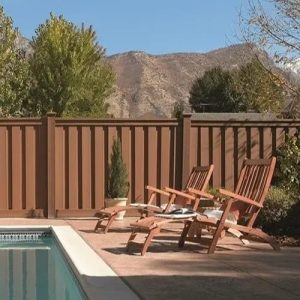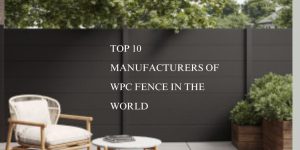Nowadays, fencing has regarded as a necessary decoration in daily life. Composite fencing satisfied the need for a fence that combined the strength and beauty of real wood with the minimal-maintenance characteristics of vinyl or PVC fencing. This special product maximizes the benefits of timber and vinyl while minimizing their drawbacks.
In this article, we explore the definition and benefits of vertical composite fencing to offer customers a more comprehensive guide to vertical composite fencing.

What is vertical composite fencing?
Vertical composite fencing is comprised of a blend of recycled sawdust and plastic to make a sturdy and long-lasting fence. Vertical WPC fencing has gained popularity as a decorative option for homes and gardens in recent years. It is a more sustainable and environmentally friendly alternative when compared to other fencing materials, which is good for both the environment and human health.
Thanks to its waterproof and weather-resistant features, Unifloor vertical composite fencing is frequently applied to fences, doors, and gates for gardens, yards, patios, cottages, etc.

Is vertical composite fencing eco-friendly?
Vertical composite fencing is 100% eco-friendly. Not only fabricated from recycled components, but it also has a much longer lifespan than fencing built entirely of wood. As a consequence, fewer trees will need to be chopped in order to replace fence panels. So, we think Vertical WPC fencing is a terrific option for you if you’re environmentally conscious and want to do your part to protect the environment.

Benefits of vertical composite fencing
- Vertical composite fencing is adored by homeowners not just for its aesthetic appeal but also for the privacy, security, and safety it provides. Our vertical WPC fences provide excellent seclusion. Nobody will be allowed to enter or view your property.
- Since the fencing interlocking pickets are sturdier than vinyl and wood and can prevent warping and bending, gaps are never an issue with vertical composite fencing compared to fencing made from wood. With interconnecting panels permanently fixed in place, You can chill with your family without ever being bothered by passers-by.
- Vertical WPC fencing is an excellent substitute for real wood because it requires very little upkeep. It does not require painting or staining and is simply cleaned with a simple soap-and-water solution. The fencing is resistant to insects, termites, etc.

What are the cons of vertical composite fencing?
Besides the many advantages of vertical composite fencing, there is one tiny disadvantage, namely the initial cost.
Vertical composite fencing may cost a little more than conventional timber fencing. But you should keep in mind that your fence’s durability will affect how cost-effective it is in the long run.
Considering the fact that your WPC fencing lasts longer than traditional wood, it is well worth the extra initial expense. Moreover, it will save the cost and labor of replacing a standard fence for a second or even third time.







